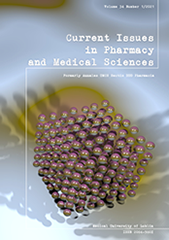Peculiarities of the effects of a high-calorie diet on the structural components of the lymph nodes and under melatonin correction
DOI:
https://doi.org/10.2478/cipms-2021-0003Keywords:
experiment, lymph nodes, sodium glutamate, melatonineAbstract
Obesity is a chronic recurrent disease that is manifested by excess accumulation of adipose tissue and is a consequence of an imbalance in energy utilization and consumption in persons with or without hereditary predisposition. The purpose of the study is to study the morphometric and histological changes of the parenchyma of the lymph nodes of rats in experimental obesity and under the conditions of melatonin correction. The study was performed on 66 white rats of reproductive age. Microanatomy of the structural components of lymph nodes of white rats under physiological norms was examined in 10 intact animals. Experimental animals were divided into 4 groups. Eight weeks after the experimental animals were on a high calorie diet (HCD), there was a significant decrease in the relative area of the cortical substance in the parenchyma of the lymph nodes of white rats of males and females by 10.3% and 8.3%, respectively, and an increase in the relative area of the medullary substance by 16.1% and 13.2%, respectively, compared to an intact group of animals.
The relative area of the cortical substance in the parenchyma of the lymph nodes of white rats, which were for two weeks on HCD, then six weeks on HCD and melatonin, exceeds the parameters of the intact group of animals by only 3.2% in males and 3.5% in females. The relative area of the medullary substance is less than that of the intact group of animals by 5.0% in males and 5.5% in females. Under the conditions of melatonin correction it is found that the germinal centers of the secondary lymph nodes in the cortical substance are slightly increased. Trabecules extending from the capsule are clearly expressed and thickened, while arteries and arterioles show thickened walls and are full-blooded. Moreover, the veins are enlarged and full-blooded.
References
1. Andersen CJ, Murphy KE, Fernandez ML. Impact of obesity and metabolic syndrome on immunity. Adv Nutr. 2016;7(1):66-75.
2. He K, Zhao L, Daviglus ML, Dyer AR, Horn LV, Garside D, et al. Association of monosodium glutamate intake with overweight in Chinese adults: the INTERMAP Study. Obesity. 2008;16(8):1875-80.
3. Beltiukova SV. Opredelenie glutamata natriia metodom tonkosloinoi khromatografii s liuminestsentnym detektirovaniem. Visnyk ONU. Khimiia. 2016;1(57):50-8.
4. Kothari V, Luo Y, Tornabene T, O’Neill AM, Greene MW, Geetha T, et al. High fat diet induces brain insulin resistance and cognitive impairment in mice. Biochim Biophys Acta. 2017;1863:499-508.
5. Wan H, Wu S, Wang J, Yang Y, Zhu J, Shao X, et al. Body mass index and the risk of all-cause mortality among patients with nonvalvular atrial fibrillation: a multicenter prospective observational study in China. Eur J Clin Nutr. 2017;71(4):494-9.
6. Guarner V, Rubio-Ruiz ME. Low-grade systemic inflammation connects aging, metabolic syndrome and cardiovascular disease. Interdiscip Top Gerontol. 2015;40:99-106.
7. Weitman ES, Aschen SZ, Farias-Eisner G, Albano N, Cuzzone DA, Ghanta S, et al. Obesity impairs lymphatic fluid transport and dendritic cell migration to lymph nodes. PLoS One. 2013;8(8):e70703.
8. Magnuson AM, Regan DP, Fouts JK, Booth AD, Dow SW, Foster MT. Diet-Induced obesity causes visceral, but not subcutaneous, lymph node hyperplasia via increases in specific immune cell populations. Cell Prolif. 2017;50(5):e12365.
9. Sato MN, Suzui M, Yoshino H, Kaburagi T, Sato K. Long term effects of high fat and sucrose diets on obesity and lymphocyte proliferation in mice. J Nutr Health Aging. 2009;13:602-6.
10. Suami H, Scaglioni MF. Lymphatic territories (lymphosomes) in the rat: an anatomical study for future lymphatic research. Plast Reconstr Surg. 2017;140(5):945-51.
11. Versini M, Jeandel PY, Rosenthal E, Shoenfeld Y. Obesity in autoimmune diseases: not a passive bystander. Autoimmun Rev. 2014;13:981‐1000.
12. Yeh C-M, Su S-C, Lin C-W, Yang W-E, Chien M-H, Reiter RJ, et al. Melatonin as a potential inhibitory agent in head and neck cancer. Oncotarget. 2017;8(52):90545-56.
13. Buonfiglio D, Parthimos R, Dantas R, Silva RC, Gomes G, Andrade-Silva J, et al. Melatonin absence leads to long-term leptin resistance and overweight in rats. Front Endocrinol (Lausanne). 2018;27(9):122.
14. Tan DX, Hardeland R, Back K, Manchester LC, Alatorre-Jimenez MA, Reiter RJ. On the significance of an alternate pathway of melatonin synthesis via 5-methoxytryptamine: comparisons across species. J Pineal Res. 2016;61:27-40.
15. Kalmykova O, Dzerzhynsky M. The effects of melatonin administration in different times of day on the brown adipose tissue in rats with high-calorie diet-induced obesity. Bull T Shevchenko Nat Univ Kyiv Ser Biol. 2019;77:55-61.
16. Manchester LC, Coto-Montes A, Boga JA, Andersen LP, Zhou Z, Galano A, et al. Melatonin: an ancient molecule that makes oxygen metabolically tolerable. J Pineal Res. 2015;59:403-19.
17. Souza CAP, Gallo CC, Camargo LS, Carvalho PVV, Olescuck IF, Macedo F, et al. Melatonin multiple effects on brown adipose tissue molecular machinery. J Pineal Res. 2019;66(2):e12549.
18. Yoshida K, Nakashima E, Kubo Y, Yamaoka M, Kajimura J, Kyoizumi S, et al. Inverse associations between obesity indicators and thymic T-cell production levels in aging atomic-bomb survivors. PLOS ONE. 2014;9(6):98-101.
19. Lobov GI, Pan’kova MN, Abdreshov SN. Transport function of the lymph nodes in young and old animals. Uspekhi Gerantol. 2015;28(4):681-6.
20. Demchenko GA, Abdreshov SN, Nurmakhanova BA. Contractile activity of lymph nodes in young, middle-aged, and old rats. Bull Exp Biol Med. 2019;67:194-7.
21. Winer DA, Winer S, Chng MH, Shen L, Engleman EG. B lymphocytes in obesity- related adipose tissue inflammation and insulin resistance. Cell Mol Life Sci. 2014;71:1033-43.
22. Calvo JR, Gonzalez-Yanes C, Maldonado MD. The role of melatonin in the cells of the innate immunity: a review. J Pineal Res. 2013; 55:103-20.
23. Do Amaral FG, Andrade-Silva J, Kuwabara W, Cipolla-Neto J. New insights into the function of melatonin and its role in metabolic disturbances. Expert Rev Endocrinol Metab. 2019;14(4):299-303.
Downloads
Published
Issue
Section
License
Copyright (c) 2021 Authors

This work is licensed under a Creative Commons Attribution-NonCommercial-NoDerivatives 3.0 Unported License.


